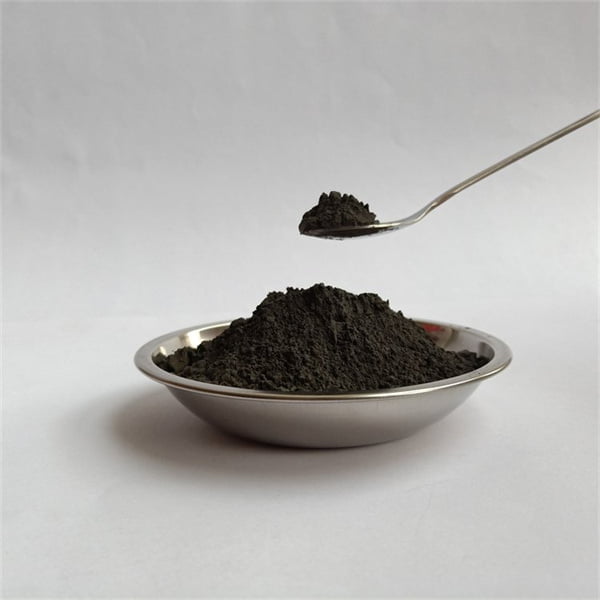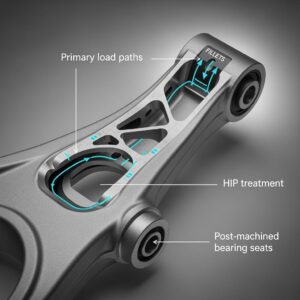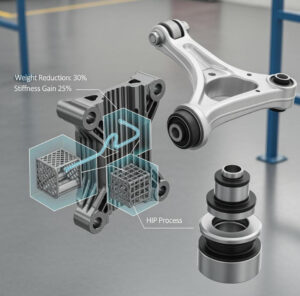Inleiding tot mechanisch legeren voor 3D printen van metaalpoeder
Inhoudsopgave
De wereld van 3D-printen metaalpoeder blijft zich in een verbazingwekkend tempo ontwikkelen en verlegt de grenzen van wat mogelijk is op het gebied van ontwerp, complexiteit en materiaalkeuze. Met name de additieve metaalproductie heeft deuren geopend voor het creëren van ingewikkelde en functionele objecten rechtstreeks vanuit digitale modellen. Maar heb je je ooit afgevraagd hoe het metaalpoeder dat in deze printers wordt gebruikt, überhaupt wordt geproduceerd? Betreed mechanisch legeren, een fascinerende technologie die een cruciale rol speelt bij het creëren van hoogwaardige 3D-printen metaalpoeder.
de basisprincipes van mechanisch legeren
Stel je voor dat je een cocktailshaker hebt gevuld met verschillende gekleurde snoepjes. Door krachtig te schudden, worden de snoepjes gemengd, waardoor een schijnbaar uniforme mix ontstaat. Dit is in wezen het basisprincipe achter mechanisch legeren. Het is een vaste-stof poederverwerkingstechniek die gebruik maakt van ball milling met hoge energie om meerdere metaalpoeders op atomair niveau intensief te mengen en te mengen.
Hier is een meer gedetailleerde uitsplitsing van het proces:
- Poederselectie: De eerste stap omvat het zorgvuldig selecteren van de gewenste metaalpoeders op basis van de uiteindelijke materiaaleigenschappen en toepassingsvereisten. Dit kan individuele elementen, voorgelegeerde poeders of zelfs combinaties van beide omvatten.
- Freesproces: De geselecteerde poeders worden vervolgens in een ball mill met hoge energie geladen, die in wezen fungeert als een gigantische shaker. In de molen botsen talloze ballen van een harder materiaal (vaak staal of keramiek) met hoge snelheid op de poederdeeltjes. Deze intense mechanische kracht breekt, vervormt en last de poederdeeltjes aan elkaar, waardoor intensief mengen wordt bevorderd en een nieuwe, gehomogeniseerd poedermateriaal met unieke eigenschappen.
- Poederverzameling en -verwerking: Na een vooraf bepaalde maaltijd wordt het resulterende poeder verzameld en ondergaat het verdere verwerkingsstappen zoals zeven en classificatie om de gewenste deeltjesgrootteverdeling en morfologie te bereiken.
Zie het als volgt: Stel je voor dat je met de hand chocoladeschilfers en bloem probeert te mengen. Je zou kunnen eindigen met een enigszins gemengd mengsel, maar er zullen nog steeds afzonderlijke zakken van elk ingrediënt zijn. Mechanisch legeren daarentegen is als het plaatsen van deze ingrediënten in een krachtige blender, waardoor een veel uniformer en consistenter mengsel wordt bereikt op het niveau van de afzonderlijke deeltjes.

Hoe mechanisch legeren toe te passen op de productie van 3D-geprinte metaalpoeders
Mechanisch legeren biedt een veelzijdige aanpak voor het produceren van metaalpoeders die specifiek zijn afgestemd op 3D-printtoepassingen. Hier is hoe het een sleutelrol speelt:
- Nieuwe legeringen creëren: Door verschillende elementaire poeders te mengen, maakt mechanisch legeren de creatie mogelijk van nieuwe legeringen met specifieke eigenschappen die niet gemakkelijk beschikbaar zijn in conventionele vormen. Dit opent deuren voor het aanpassen van materiaaleigenschappen zoals sterkte, corrosiebestendigheid en thermisch gedrag voor specifieke 3D-printtoepassingen.
- Poedereigenschappen verbeteren: Mechanisch legeren kan ook de vloeibaarheid, pakdichtheid en algehele printbaarheid van bestaande metaalpoeders verbeteren. Door de deeltjesgrootte en morfologie te verfijnen, wordt het poeder geschikter voor verschillende 3D-printprocessen zoals laserpoederbedfusie (LPBF) en electron beam melting (EBM).
- Composietpoeders mogelijk maken: Deze techniek effent ook de weg voor de ontwikkeling van metaalmatrixcomposieten (MMC's) voor 3D-printen. Door keramische of andere versterkende deeltjes in de metaalmatrix te verwerken door middel van mechanisch legeren, biedt het resulterende poeder verbeterde mechanische eigenschappen zoals slijtvastheid en prestaties bij hoge temperaturen.
In wezen fungeert mechanisch legeren als een krachtig hulpmiddel voor het ontsluiten van het potentieel van 3D-printmetalen door de creatie mogelijk te maken van nieuwe materialen met precies op maat gemaakte eigenschappen om te voldoen aan de eisen van diverse toepassingen.
De voordelen van mechanisch legeren in 3D printen van metaalpoeders
In vergelijking met traditionele poederproductiemethoden zoals verstuiving, biedt mechanisch legeren verschillende duidelijke voordelen voor 3D-printen:
- Grotere samenstellingscontrole: Het maakt de creatie mogelijk van precieze en uniforme legeringen met specifieke samenstellingen, niet beperkt tot kant-en-klare voorgelegeerde poeders.
- Verbeterde poedereigenschappen: Het proces verfijnt de poederdeeltjes, waardoor hun vloeibaarheid, pakdichtheid en printbaarheid worden verbeterd, wat leidt tot betere prestaties in 3D-printprocessen.
- Ontwikkeling van nieuwe materialen: Het opent deuren voor de creatie van unieke legeringen en metaalmatrixcomposieten met eigenschappen die niet haalbaar zijn met conventionele methoden, waardoor de mogelijkheden voor 3D-printtoepassingen worden uitgebreid.
- Schaalbaarheid: Mechanisch legeren kan worden aangepast om kleine of grote batches poeder te produceren, waardoor het geschikt is voor zowel onderzoek als industriële productie.
Het is echter belangrijk om te erkennen dat mechanisch legeren ook bepaalde beperkingen met zich meebrengt:
- Verwerkingstijd: Het freesproces kan tijdrovend en energie-intensief zijn, vooral voor hardere of complexere materiaalcombinaties.
- Verontreinigingspotentieel: Zorgvuldige selectie van maalmedia en procescontrole zijn cruciaal om minimaliseer contaminatie van de maalballen of de omgeving.
- Kostenoverwegingen: Het opzetten en onderhouden van hoge-
Specifieke metaalpoedermodellen voor 3D-printen met mechanische legering
Hoewel de kernfunctionaliteiten consistent blijven, zijn specifieke metaalpoedermodellen die via mechanische legering worden geproduceerd, geschikt voor diverse 3D-printtoepassingen en prestatie-eisen. Hier zijn 10 opmerkelijke voorbeelden:
1. Inconel 625: Dit nikkel-chroom-gebaseerde superlegeringspoeder beschikt over uitzonderlijke sterkte bij hoge temperaturen, oxidatiebestendigheid en kruipweerstand. Het is bijzonder geschikt voor veeleisende toepassingen zoals lucht- en ruimtevaartcomponenten, gasturbineonderdelen en warmtewisselaars in de 3D-printwereld.
2. Ti-6Al-4V: Dit werkpaard van een titaniumlegeringspoeder biedt een uitstekende balans tussen sterkte, gewicht en biocompatibiliteit. Het wordt veel gebruikt in de medische en lucht- en ruimtevaartindustrie voor toepassingen zoals orthopedische implantaten, vliegtuigonderdelen en op maat gemaakte prothesen dankzij de gunstige eigenschappen bij productie via mechanische legering.
3. AlSi10Mg: Dit aluminium-silicium-magnesiumlegeringspoeder staat bekend om zijn goede gietbaarheid, lasbaarheid en corrosiebestendigheid. Het vindt toepassingen in verschillende sectoren, waaronder de automobielindustrie, de lucht- en ruimtevaart en consumentengoederen, dankzij de combinatie van printbaarheid en mechanische eigenschappen die haalbaar zijn door mechanische legering.
4. Cu-Sn10: Dit koper-tinlegeringspoeder biedt superieure elektrische geleidbaarheid en slijtvastheid. Het wordt vaak gebruikt bij de productie van elektrische componenten zoals koellichamen, stroomrails en connectoren, waar de eigenschappen, verbeterd door mechanische legering, cruciaal zijn voor de prestaties.
5. CoCrMo: Dit kobalt-chroom-molybdeenlegeringspoeder staat bekend om zijn hoge biocompatibiliteit, slijtvastheid en corrosiebestendigheid. Het is een populaire keuze voor het 3D-printen van medische implantaten zoals heup- en knievervangingen, waar de biocompatibiliteit en mechanische eigenschappen die door mechanische legering worden bereikt, van het grootste belang zijn.
7. Inconel 718: Dit nikkel-chroom-gebaseerde superlegeringspoeder staat bekend om zijn uitzonderlijke sterkte bij hoge temperaturen, goede oxidatiebestendigheid en uitstekende kruipweerstand. Het wordt vaak gebruikt in veeleisende toepassingen zoals turbinebladen, raketmotoronderdelen en andere hoogwaardige onderdelen, waar de eigenschappen die door mechanische legering haalbaar zijn, essentieel zijn.
8. Maraging Steel 300: Dit hoogsterkte, koolstofarme staalpoeder biedt superieure sterkte en taaiheid na warmtebehandeling. Het wordt gebruikt in diverse toepassingen die een hoge sterkte-gewichtsverhouding vereisen, zoals lucht- en ruimtevaartcomponenten, gereedschappen en defensiematerieel, waar de eigenschappen die door mechanische legering worden verkregen, cruciaal zijn.
9. Nikkel Aluminium Brons (NAB): Dit koper-aluminium-nikkellegeringspoeder levert uitstekende corrosiebestendigheid, slijtvastheid en goede mechanische eigenschappen. Het vindt toepassingen in maritieme componenten, lagers en slijtdelen, waar de printbaarheid en eigenschappen, verbeterd door mechanische legering, voordelig zijn.
10. Hastelloy C-276: Dit nikkel-chroom-molybdeenlegeringspoeder staat bekend om zijn uitzonderlijke corrosiebestendigheid in een breed scala aan agressieve omgevingen. Het wordt gebruikt in chemische verwerkingsapparatuur, systemen voor verontreinigingsbestrijding en andere toepassingen die superieure weerstand tegen agressieve chemicaliën vereisen, waar de eigenschappen die door mechanische legering worden bereikt, van vitaal belang zijn.
Het is belangrijk om te onthouden dat dit slechts enkele voorbeelden zijn en dat de mogelijkheden met mechanisch gelegeerde poeders voortdurend worden uitgebreid. Naarmate de technologie vordert, kunnen we verwachten dat we nog meer innovatieve en gespecialiseerde metaalpoeders zullen zien die zijn afgestemd op de specifieke behoeften van verschillende 3D-printtoepassingen.
Vergelijking van metaalpoedermodellen voor 3D-printen
Bij het kiezen van een metaalpoedermodel voor uw 3D-printproject moeten verschillende factoren in overweging worden genomen:
- Gewenste eigenschappen: Identificeer de cruciale eigenschappen die uw afgewerkte onderdeel nodig heeft, zoals sterkte, gewicht, corrosiebestendigheid, biocompatibiliteit of elektrische geleidbaarheid.
- Toepassingsvereisten: Houd rekening met de specifieke toepassing en de omgevingsomstandigheden waaraan het onderdeel wordt blootgesteld.
- 3D-printproces: Stem de poedereigenschappen zoals deeltjesgrootte en vloeibaarheid af op het specifieke 3D-printproces dat u gaat gebruiken (bijvoorbeeld LPBF, EBM).
Hier is een korte vergelijking van enkele belangrijke eigenschappen voor de genoemde metaalpoedermodellen:
| Metaal Poeder Model | Sterkte (MPa) | Dichtheid (g/cm³) | Smeltpunt (°C) | Toepassingen |
|---|---|---|---|---|
| Inconel 625 | Beschikt over uitzonderlijke sterkte bij hoge temperaturen, waardoor het ideaal is voor veeleisende toepassingen zoals lucht- en ruimtevaartcomponenten en warmtewisselaars. | Bezit een hoge dichtheid van 8,44 g/cm³, wat bijdraagt aan zijn robuuste aard. | Biedt een smeltpunt van 1455°C, waardoor het bestand is tegen extreme temperaturen. | Veel gebruikt in de lucht- en ruimtevaart, gasturbines en warmtewisselaars vanwege de combinatie van sterkte, weerstand tegen hoge temperaturen en goede printbaarheid. |
| Ti-6Al-4V | Biedt een uitstekende balans tussen sterkte, gewicht en biocompatibiliteit, waardoor het geschikt is voor toepassingen zoals orthopedische implantaten en prothesen. | Vertoont een gemiddelde dichtheid van 4,43 g/cm³, wat een goede balans biedt tussen gewicht en sterkte. | Smelt bij een temperatuur van ongeveer 1600°C, wat aantoont dat het bestand is tegen hoge temperaturen. | Een populaire keuze in de medische en lucht- en ruimtevaartindustrie vanwege de biocompatibiliteit, gunstige sterkte-gewichtsverhouding en goede printbaarheid. |
| AlSi10Mg | Bekend om zijn goede gietbaarheid, lasbaarheid en corrosiebestendigheid, waardoor het veelzijdig is voor verschillende toepassingen. | Bezit een lagere dichtheid van ongeveer 2,7 g/cm³, wat bijdraagt aan zijn lichtgewicht eigenschappen. | Smelt bij een relatief lagere temperatuur in vergelijking met andere, rond de 577°C, wat in sommige gevallen een eenvoudigere verwerking biedt. | Veel gebruikt in de automobiel-, lucht- en ruimtevaart- en consumentengoederensectoren vanwege de printbaarheid, gunstige mechanische eigenschappen en goede gietbaarheid. |
| Cu-Sn10 | Levert superieure elektrische geleidbaarheid en slijtvastheid, waardoor het waardevol is voor toepassingen zoals elektrische componenten en koellichamen. | Vertoont een gemiddelde dichtheid van ongeveer 8,9 g/cm³, waarbij de elektrische geleidbaarheid wordt afgewogen tegen gewichtsoverwegingen. | Smelt bij een temperatuur van ongeveer 830°C, wat een goede bewerkbaarheid en printbaarheid biedt. | Vaak gebruikt bij de productie van elektrische componenten zoals koellichamen en stroomrails vanwege de uitzonderlijke elektrische geleidbaarheid en slijtvastheid. |
| CoCrMo | Bekend om zijn hoge biocompatibiliteit, slijtvastheid en corrosiebestendigheid, waardoor het een topkeuze is voor medische implantaten. | Bezit een hoge dichtheid van ongeveer 8,3 g/cm³, wat bijdraagt aan de duurzaamheid en slijtvastheid. | Smelt bij een temperatuur van ongeveer 1350°C, wat aantoont dat het bestand is tegen hoge temperaturen tijdens verschillende processen. | Uitgebreid gebruikt in de medische sector voor toepassingen zoals heup- en knievervangingen vanwege de uitstekende biocompatibiliteit, goede printbaarheid en slijtvastheid. |

Aanvullende overwegingen en toekomstperspectieven van mechanische legering in 3D-printen
Hoewel mechanische legering talrijke voordelen biedt voor 3D printen van metaalpoeders, is het essentieel om een aantal aanvullende factoren te overwegen:
- Kosten: Het proces kan duurder in vergelijking met traditionele poederproductiemethoden zoals verstuiving, vooral voor grotere hoeveelheden.
- Procesbeheersing: Strikte controle over maalparameters en apparatuur is cruciaal om een consistente poederkwaliteit te garanderen en contaminatierisico's te minimaliseren.
- Invloed op het milieu: Het energieverbruik dat gepaard gaat met het maalproces vereist overweging van duurzaamheid en potentiële milieu-impact.
Ondanks deze overwegingen ziet de toekomst van mechanische legering in 3D-printen er rooskleurig uit. Hier zijn enkele spannende mogelijkheden om naar uit te kijken:
- Ontwikkeling van nieuwe legeringen: De technologie zal de weg blijven effenen voor de creatie van nieuwe legeringen met unieke eigenschappen, waardoor de grenzen van wat haalbaar is in 3D-printen worden verlegd.
- Verbeterde procesefficiëntie: Verbeteringen in de maaltechnologie en procesoptimalisatie kunnen leiden tot verhoogde efficiëntie en lagere kosten, waardoor het toegankelijker wordt voor diverse toepassingen.
- Nanocomposietpoeders: De toekomst kan de ontwikkeling van nanocomposietpoeders met uitzonderlijke eigenschappen zien, waardoor het potentieel van 3D-printen voor geavanceerde toepassingen verder wordt uitgebreid.
Concluderend kan worden gesteld dat mechanische legering een krachtig hulpmiddel is om het potentieel van 3D-printen van metalen te ontsluiten. Door de creatie van nieuwe materialen met op maat gemaakte eigenschappen mogelijk te maken en de vooruitgang in het veld te bevorderen, effent deze technologie de weg voor de creatie van innovatieve, hoogwaardige en functionele objecten in diverse industrieën. Naarmate onderzoek en ontwikkeling doorgaan, kunnen we nog meer spannende mogelijkheden verwachten, die de toekomst van 3D-printen van metalen vormgeven.
FAQ
V: Wat zijn de voordelen van het gebruik van mechanisch gelegeerde poeders bij 3D printen?
A: Er zijn verschillende voordelen, waaronder:
- Grotere controle over de samenstelling: Maakt de creatie van precieze en uniforme legeringen met specifieke samenstellingen mogelijk.
- Verbeterde poedereigenschappen: Verbetert de vloeibaarheid, de pakdichtheid en de printbaarheid voor betere prestaties in 3D-printprocessen.
- Ontwikkeling van nieuwe materialen: Maakt de creatie van unieke legeringen en metaalmatrixcomposieten mogelijk met eigenschappen die niet haalbaar zijn met conventionele methoden.
- Schaalbaarheid: Aanpasbaar om kleine of grote batches poeder te produceren voor zowel onderzoek als industriële productie.
V: Wat zijn enkele beperkingen van het gebruik van mechanisch gelegeerde poeders?
A: Potentiële beperkingen zijn onder meer:
- Verwerkingstijd: Het maalproces kan tijdrovend en energie-intensief zijn, vooral voor complexe materiaalsamenstellingen.
- Verontreinigingspotentieel: Zorgvuldige selectie van maalmedia en procescontrole zijn cruciaal om contaminatie te minimaliseren.
- Kostenoverwegingen: Het opzetten en onderhouden van hoogenergetische maalapparatuur kan duur zijn.
V: Met welke factoren moet rekening worden gehouden bij het kiezen van een metaalpoedermodel voor 3D-printen?
A: Belangrijke factoren zijn onder meer:
- Gewenste eigenschappen: Identificeer de cruciale eigenschappen die uw eindproduct nodig heeft (sterkte, gewicht, corrosiebestendigheid, enz.).
- Toepassingsvereisten: Overweeg de specifieke toepassing en de omgevingsomstandigheden waaraan het onderdeel wordt blootgesteld.
- 3D-printproces: Stem de poedereigenschappen (deeltjesgrootte, vloeibaarheid) af op het specifieke 3D-printproces dat u gaat gebruiken.
V: Wat is de toekomstverwachting voor mechanische legering in 3D-printen?
A: De toekomst ziet er veelbelovend uit, met potentieel voor:
- Ontwikkeling van nieuwe legeringen: Creatie van nieuwe legeringen met unieke eigenschappen, waardoor de mogelijkheden van 3D-printen worden uitgebreid.
- Verbeterde procesefficiëntie: Verbeteringen in de maaltechnologie en procesoptimalisatie kunnen leiden tot verhoogde efficiëntie en lagere kosten.
- Nanocomposietpoeders: Ontwikkeling van nanocomposietpoeders met uitzonderlijke eigenschappen, waardoor het potentieel van 3D-printen voor geavanceerde toepassingen verder wordt uitgebreid.
Door het potentieel en de beperkingen van mechanische legering te begrijpen, kunnen we deze technologie benutten om innovatieve en functionele 3D-geprinte objecten te creëren, die de toekomst van verschillende industrieën vormgeven.
Delen op
MET3DP Technology Co, LTD is een toonaangevende leverancier van additieve productieoplossingen met hoofdkantoor in Qingdao, China. Ons bedrijf is gespecialiseerd in 3D printapparatuur en hoogwaardige metaalpoeders voor industriële toepassingen.
Onderzoek om de beste prijs en een op maat gemaakte oplossing voor uw bedrijf te krijgen!
gerelateerde artikelen

Metal 3D Printing for U.S. Automotive Lightweight Structural Brackets and Suspension Components
Lees verder "Over Met3DP
Recente update
Ons product
NEEM CONTACT MET ONS OP
Nog vragen? Stuur ons nu een bericht! Na ontvangst van uw bericht behandelen wij uw verzoek met een heel team.

















